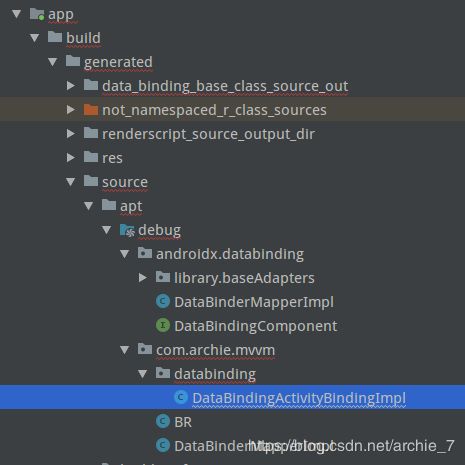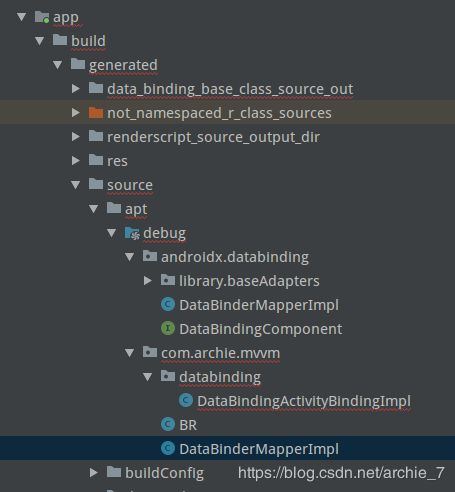Databinding使用、Databinding原理、Androidx集成Databinding、Databinding源码分析、Databinding双向绑定原理
简介
Databinding是谷歌的一个官方支持库,它允许您使用声明性格式而不是通过编程方式将布局中的UI组件绑定到应用程序中的数据源。
通常在活动中使用调用UI框架方法的代码来定义布局。例如,调用findViewById()以查找TextView窗口小部件并将其绑定到变量。
因为它通过在布局文件中绑定组件,您可以删除活动中的许多UI框架调用,从而使它们更易于维护。这也可以提高应用程序的性能,并有助于防止内存泄漏和空指针异常。
Androidx集成Databinding
1、将dataBinding元素添加到 build.gradle应用程序模块中
android {
......
dataBinding {
enabled = true
}
}
2、gradle编译会根据dataBinding设置自动引包,无需个人添加implementation等。因此,需要在项目中配置Androidx环境。
文件位置:项目根目录gradle.properties
android.useAndroidX=true
android.enableJetifier=true
Databinding使用
Databinding的改动主要涉及两个模块,一个模块为布局文件layout,另一个模块为数据提供方(Activity,Fragment,或者viewmodel,这里我们以Activity为例子)。
一、 layout模块变动,布局文件的最外层需要套一层layout标签。
<?xml version="1.0" encoding="utf-8"?>
<layout xmlns:android="http://schemas.android.com/apk/res/android"
xmlns:app="http://schemas.android.com/apk/res-auto">
<data>
<variable
name="productInfo"
type="com.archie.mvvm.entity.ProductInfo" />
<variable
name="isLate"
type="com.archie.mvvm.entity.ProductInfo" />
</data>
<LinearLayout
android:layout_width="match_parent"
android:layout_height="match_parent"
android:orientation="vertical">
// 利用TextView测试单向数据绑定
<TextView
android:layout_width="match_parent"
android:layout_height="wrap_content"
android:text="@{productInfo.name}" />
// 利用CheckBox测试双向数据绑定
<CheckBox
android:layout_width="match_parent"
android:layout_height="wrap_content"
android:checked="@={productInfo.isLate}"
android:onCheckedChanged="@{productInfo::onClickBox}" />
</LinearLayout>
</layout>
二、layout布局文件的data标签绑定了类数据ProductInfo
public class ProductInfo {
public String name;
public boolean isLate;
public ProductInfo(String name, boolean isLate) {
this.name = name;
this.isLate = isLate;
}
}
三、数据提供方Activity代码
layout布局文件写完执行build->rebuild project会自动生成DataBindingActivityBinding对象
public class DataBindingActivity extends AppCompatActivity {
@Override
protected void onCreate(@Nullable Bundle savedInstanceState) {
super.onCreate(savedInstanceState);
DataBindingActivityBinding bindingActivityBinding =
DataBindingUtil.setContentView(this, R.layout.data_binding_activity);
bindingActivityBinding.setProductInfo(new ProductInfo("小米公交卡", true);
}
}
如上,一个比较简单的Databinding使用,Databinding使用还包含自定义view、绑定表达式等,这里不着重讲了,可以参考如下文档:
绑定表达式:
https://developer.android.google.cn/topic/libraries/data-binding/expressions
通过BindingAdapters自定义view:
https://developer.android.google.cn/topic/libraries/data-binding/binding-adapters
概念以及APT自动生成的文件
一、概念讲解
首先陈述几个Databinding相关的概念
1、Java中的APT的工作过程
APT即Annotatino Processing Tool, 他的作用是处理代码中的注解, 用来生成代码, 换句话说, 这是用代码生成代码的工具。
2、双向绑定
数据变更可以通知到控件,控件的状态变更(例如checkbox的开关)会同步到绑定的数据对象。
3、Databinding跟mvvm模式的关系
Databinding本质跟mvvm并没有关系,它的出现因为屏蔽了findviewbyid,所以有助于防止内存泄漏和空指针异常。属于view层的优化。
4、使用双向数据绑定的无限循环
使用双向数据绑定时,请注意不要引入无限循环。当用户更改属性时,使用注释的方法将 @InverseBindingAdapter被调用,并将该值分配给属性。反过来,这将调用使用注释的方法 @BindingAdapter,这将触发对使用注释的方法的另一次调用@InverseBindingAdapter,依此类推。
因此,在使用注释的方法中,通过比较新值和旧值来打破可能的无限循环非常重要。
这里列一个防止无限循环的例子:
public class CompoundButtonBindingAdapter {
@BindingAdapter("android:checked")
public static void setChecked(CompoundButton view, boolean checked) {
// 这里通过比较新值和旧值来打破可能的无限循环
if (view.isChecked() != checked) {
view.setChecked(checked);
}
}
}
二、APT技术自动生成的文件
1、layout转换的文件
文件位置build/intermediates/下

文件内容
这里就不贴全部代码了,着重贴下双向绑定跟单向绑定的区别: TwoWay标签值不同
<Target tag="binding_1" view="TextView">
<Expressions>
<Expression attribute="android:text" text="productInfo.name">
<TwoWay>false</TwoWay>
</Expression>
</Expressions>
</Target>
<Target tag="binding_2" view="CheckBox">
<Expressions>
<Expression attribute="android:checked" text="productInfo.isLate">
<TwoWay>true</TwoWay>
</Expression>
</Expressions>
<location endLine="37" endOffset="67" startLine="33" startOffset="8" />
</Target>
2、生成的Binding管理类
DataBindingActivityBindingImpl类,用户向布局文件下发数据,ui展示。

源码逻辑分析
一、Activity或者Fragment绑定layout
1、首先会通过DataBindingUtil拿到Binding类,同时会绑定layout
DataBindingActivityBinding bindingActivityBinding =
DataBindingUtil.setContentView(this, R.layout.data_binding_activity);
2、DataBindingUtil的setContentView
public static <T extends ViewDataBinding> T setContentView(@NonNull Activity activity,
int layoutId, @Nullable DataBindingComponent bindingComponent) {
activity.setContentView(layoutId);
View decorView = activity.getWindow().getDecorView();
ViewGroup contentView = (ViewGroup) decorView.findViewById(android.R.id.content);
return bindToAddedViews(bindingComponent, contentView, 0, layoutId);
}
3、bindToAddedViews最终会到DataBindingUtil.bind
public static <T extends ViewDataBinding> T bind(@NonNull View root,
DataBindingComponent bindingComponent) {
T binding = getBinding(root);
if (binding != null) {
return binding;
}
Object tagObj = root.getTag();
if (!(tagObj instanceof String)) {
throw new IllegalArgumentException("View is not a binding layout");
} else {
String tag = (String) tagObj;
int layoutId = sMapper.getLayoutId(tag);
if (layoutId == 0) {
throw new IllegalArgumentException("View is not a binding layout. Tag: " + tagObj);
}
return (T) sMapper.getDataBinder(bindingComponent, root, layoutId);
}
}
4、sMapper同样也是apt自动生成的类
类位置

看下DataBinderMapperImpl.getDataBinder()
public ViewDataBinding getDataBinder(DataBindingComponent component, View view, int layoutId) {
int localizedLayoutId = INTERNAL_LAYOUT_ID_LOOKUP.get(layoutId);
if(localizedLayoutId > 0) {
final Object tag = view.getTag();
if(tag == null) {
throw new RuntimeException("view must have a tag");
}
switch(localizedLayoutId) {
case LAYOUT_DATABINDINGACTIVITY: {
if ("layout/data_binding_activity_0".equals(tag)) {
return new DataBindingActivityBindingImpl(component, view);
}
throw new IllegalArgumentException("The tag for data_binding_activity is invalid. Received: " + tag);
}
}
}
return null;
}
到这里DataBindingUtil关联layout同时获取Binding对象就完事了,最终通过DataBinderMapperImpl获取到DataBindingActivityBindingImpl。
二、单向数据绑定如何实现的
1、看下DataBindingActivityBindingImpl的构造方法
private DataBindingActivityBindingImpl(androidx.databinding.DataBindingComponent bindingComponent, View root, Object[] bindings) {
super(bindingComponent, root, 0
);
this.mboundView0 = (android.widget.LinearLayout) bindings[0];
this.mboundView0.setTag(null);
this.mboundView1 = (android.widget.TextView) bindings[1];
this.mboundView1.setTag(null);
this.mboundView2 = (android.widget.CheckBox) bindings[2];
this.mboundView2.setTag(null);
setRootTag(root);
// listeners
invalidateAll();
}
这里可以看到把所有的子view都数字标记了
2、这里着重看下invalidateAll()方法做了什么
public void invalidateAll() {
synchronized(this) {
mDirtyFlags = 0x10L;
}
requestRebind();
}
requestRebind方法在它的父类ViewDataBinding中
protected void requestRebind() {
if (mContainingBinding != null) {
mContainingBinding.requestRebind();
} else {
......
if (USE_CHOREOGRAPHER) {
mChoreographer.postFrameCallback(mFrameCallback);
} else {
// 这里使用了Handler启动了一个runnable任务
mUIThreadHandler.post(mRebindRunnable);
}
}
}
private final Runnable mRebindRunnable = new Runnable() {
@Override
public void run() {
......
executePendingBindings();
}
};
public void executePendingBindings() {
if (mContainingBinding == null) {
executeBindingsInternal();
} else {
mContainingBinding.executePendingBindings();
}
}
private void executeBindingsInternal() {
......
if (!mRebindHalted) {
// 这里可以看到最终执行的executeBindings
executeBindings();
if (mRebindCallbacks != null) {
mRebindCallbacks.notifyCallbacks(this, REBOUND, null);
}
}
mIsExecutingPendingBindings = false;
}
// executeBindings是个抽象方法,子类需要实现它
protected abstract void executeBindings();
这里可以看到通过Handler启动了一个runnable,执行子类的executeBindings()方法
3、所以最终回到了子类DataBindingActivityBindingImpl.executeBindings()
protected void executeBindings() {
long dirtyFlags = 0;
synchronized(this) {
dirtyFlags = mDirtyFlags;
mDirtyFlags = 0;
}
java.lang.String productInfoName = null;
boolean productInfoIsLate = false;
com.archie.mvvm.entity.ProductInfo productInfo = mProductInfo;
android.widget.CompoundButton.OnCheckedChangeListener productInfoOnClickBoxAndroidWidgetCompoundButtonOnCheckedChangeListener = null;
if ((dirtyFlags & 0x18L) != 0) {
if (productInfo != null) {
// read productInfo.name
productInfoName = productInfo.name;
// read productInfo.isLate
productInfoIsLate = productInfo.isLate;
}
}
// batch finished
if ((dirtyFlags & 0x18L) != 0) {
androidx.databinding.adapters.TextViewBindingAdapter.setText(this.mboundView1, productInfoName);
androidx.databinding.adapters.CompoundButtonBindingAdapter.setChecked(this.mboundView2, productInfoIsLate);
androidx.databinding.adapters.CompoundButtonBindingAdapter.setListeners(this.mboundView2, (android.widget.CompoundButton.OnCheckedChangeListener)productInfoOnClickBoxAndroidWidgetCompoundButtonOnCheckedChangeListener, mboundView2androidCheckedAttrChanged);
}
}
4、我们看下androidx.databinding.adapters.TextViewBindingAdapter.setText()
public static void setText(TextView view, CharSequence text) {
final CharSequence oldText = view.getText();
if (text == oldText || (text == null && oldText.length() == 0)) {
return;
}
if (text instanceof Spanned) {
if (text.equals(oldText)) {
return; // No change in the spans, so don't set anything.
}
} else if (!haveContentsChanged(text, oldText)) {
return; // No content changes, so don't set anything.
}
view.setText(text);
}
这里我们可以看到最终调用了view.setText(text)给view设置了内容。
5、单向设置数据。DataBindingActivityBindingImpl会自动生成set方法
public void setProductInfo(@Nullable com.archie.mvvm.entity.ProductInfo ProductInfo) {
this.mProductInfo = ProductInfo;
synchronized(this) {
mDirtyFlags |= 0x8L;
}
notifyPropertyChanged(BR.productInfo);
super.requestRebind();
}
public void setIsLate(@Nullable com.archie.mvvm.entity.ProductInfo IsLate) {
this.mIsLate = IsLate;
}
完结,这里可以总结下,所谓的单向数据绑定原理其实也是调用requestRebind()方法,通过Handler启动了runnable,检查数据变化;当通过set方法设置数据后,executeBindings会更新到相应的view。
三、双向数据绑定原理
双向绑定其实是在单向的基础上补充了反向数据,这里以CheckBox为例,其实上边的代码多少已经展示了,这里着重梳理下。
1、layout不同
需要使用@=标记
<CheckBox
android:layout_width="match_parent"
android:layout_height="wrap_content"
android:checked="@={productInfo.isLate}" />
2、看下InverseBindingListener
public interface InverseBindingListener {
/**
* Notifies the data binding system that the attribute value has changed.
*/
void onChange();
}
反向数据绑定是一个接口
3、看下他的实现类,代码在DataBindingActivityBindingImpl
// Inverse Binding Event Handlers
private androidx.databinding.InverseBindingListener mboundView2androidCheckedAttrChanged =
new androidx.databinding.InverseBindingListener() {
@Override
public void onChange() {
// Inverse of productInfo.isLate
// is productInfo.isLate = (boolean) callbackArg_0
boolean callbackArg_0 = mboundView2.isChecked();
// localize variables for thread safety
// productInfo.isLate
boolean productInfoIsLate = false;
// productInfo
com.archie.mvvm.entity.ProductInfo productInfo = mProductInfo;
// productInfo != null
boolean productInfoJavaLangObjectNull = false;
productInfoJavaLangObjectNull = (productInfo) != (null);
if (productInfoJavaLangObjectNull) {
productInfo.isLate = ((boolean) (callbackArg_0));
}
}
};
这里可以看到onChange内部其实是对Product对象的赋值。这里大概就能体现出Java的神奇,因为Product是个对象,所以传递的是对象的引用,这里通过对象的引用变更了对象的属性,那么内存中的这个对象本质数据已经变更。
4、接下来看下怎么回调的onChange(),其实还DataBindingActivityBindingImpl.executeBindings()
protected void executeBindings() {
......
// batch finished
if ((dirtyFlags & 0x18L) != 0) {
// api target 1
androidx.databinding.adapters.TextViewBindingAdapter.setText(this.mboundView1, productInfoName);
androidx.databinding.adapters.CompoundButtonBindingAdapter.setChecked(this.mboundView2, productInfoIsLate);
androidx.databinding.adapters.CompoundButtonBindingAdapter
.setListeners(this.mboundView2
, (android.widget.CompoundButton.OnCheckedChangeListener)productInfoOnClickBoxAndroidWidgetCompoundButtonOnCheckedChangeListener
, mboundView2androidCheckedAttrChanged);
}
}
这里可以看到androidx.databinding.adapters.CompoundButtonBindingAdapter.setListeners()设置了反向数据监听。
5、看下CompoundButtonBindingAdapter
public class CompoundButtonBindingAdapter {
@BindingAdapter("android:checked")
public static void setChecked(CompoundButton view, boolean checked) {
if (view.isChecked() != checked) {
view.setChecked(checked);
}
}
@BindingAdapter(value = {"android:onCheckedChanged", "android:checkedAttrChanged"},
requireAll = false)
public static void setListeners(CompoundButton view, final OnCheckedChangeListener listener,
final InverseBindingListener attrChange) {
if (attrChange == null) {
view.setOnCheckedChangeListener(listener);
} else {
view.setOnCheckedChangeListener(new OnCheckedChangeListener() {
@Override
public void onCheckedChanged(CompoundButton buttonView, boolean isChecked) {
if (listener != null) {
listener.onCheckedChanged(buttonView, isChecked);
}
attrChange.onChange();
}
});
}
}
}
这里很清晰了,setListeners监听了button的点击事件,最终回传到了InverseBindingListener.onChange()。然后实现类会在onChange中对对象赋值,从而做到了反向数据绑定。
总结
一个新技术的使用,必然会有很多争论点,这里说下Databinding的优缺点
优点:
1、彻底去掉了findviewbyid,并有助于防止内存泄漏和空指针异常。
2、将View层代码抽象为了数据状态,极大减少了数据层和view层的代码耦合,同时也能减少model和view的回调处理。
3、 易于维护和测试
缺点:
1、通过源码我们可以看到,维护了view数组,造成内存占用。
2、使用了handler和looper循环。
3、apt技术会生成类文件,占用内存。
任何一个技术都有优缺点,在面向对象思维的背景下,减少逻辑调用显得格外重要。作为谷歌官方的架构组件,在历史的长河中必定证明了优点大于缺点。所以,盘它。